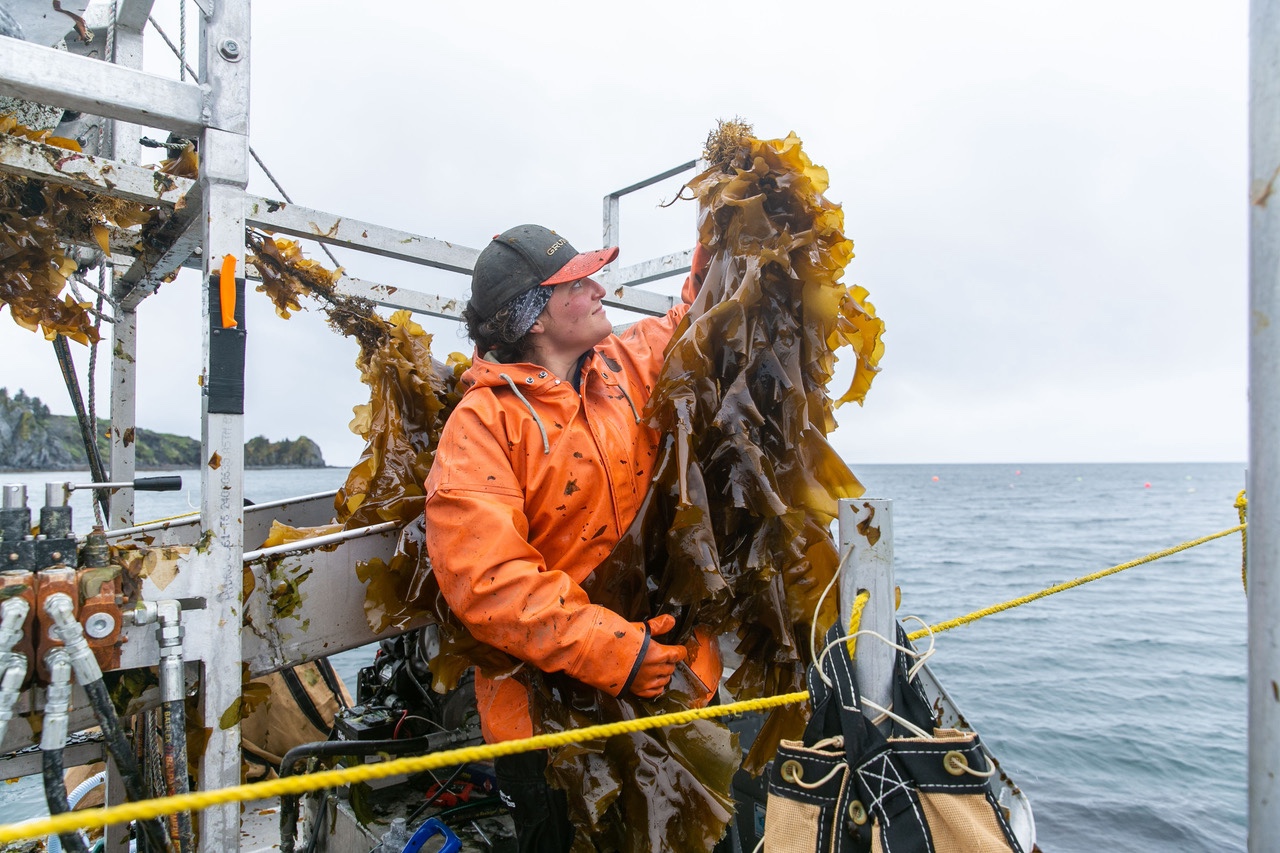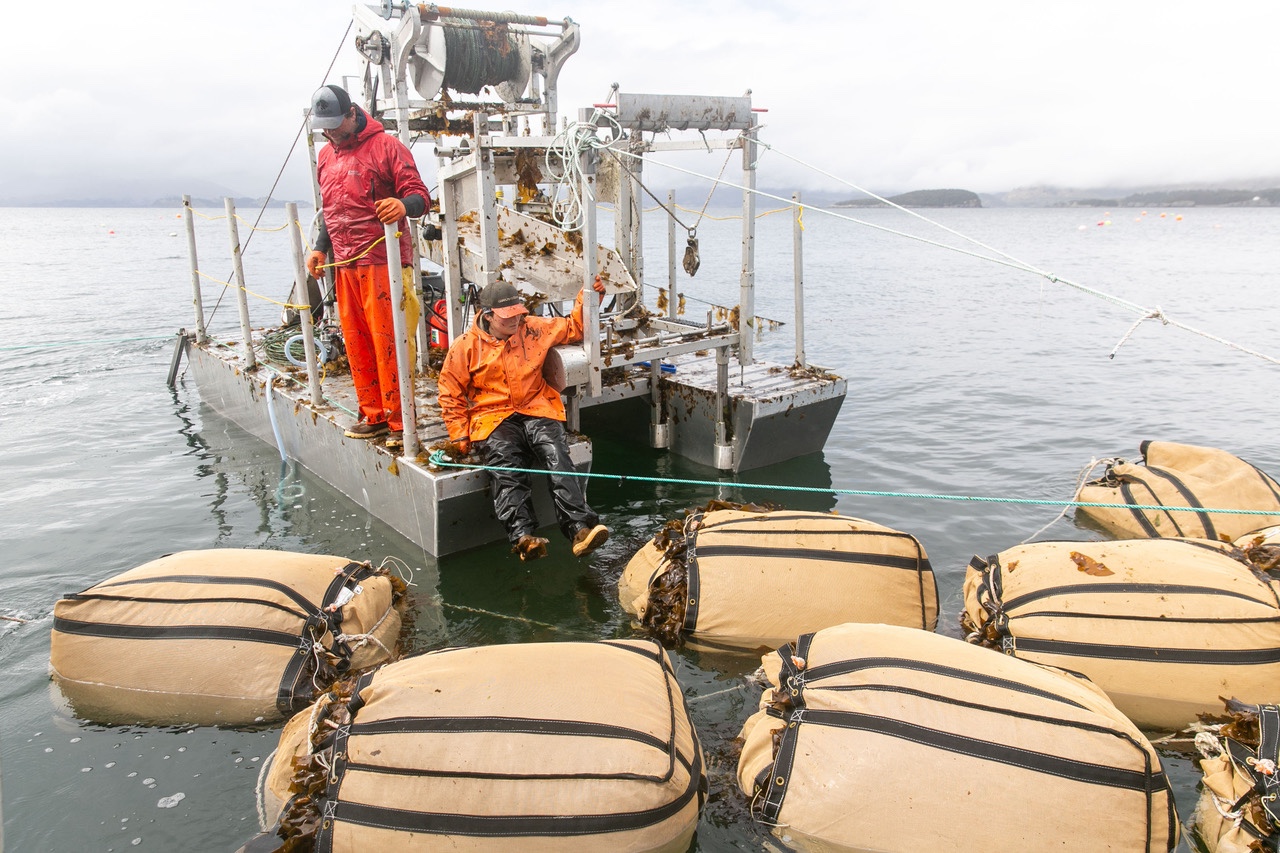
Blue Evolution grows seaweed for wide range of commercial applications, and it could be an effective way to mine minerals. (Image: Rachelle Hacmac for Blue Evolution)
This article is part of our series on responsible mining solutions. The push for clean energy is fueled by growing demand for minerals. Conventional mining has a track record of harmful social and environmental impacts. Phytomining is another potential solution to that problem.
Do you remember “The Giving Tree,” by Shel Silverstein? It’s a children’s book about an apple tree that gives a young boy everything it can, and the boy spends countless hours playing with the tree. As the boy grows older, he has less time for the tree. The tree still provides all it can, but it’s sad that the boy doesn’t visit as much as he used to. The story might make your eyes water, but did you know that the giving tree is alive and well today?
Recently scientists asked the tree for clean, renewable energy. The tree said to them, “I cannot do that. I am a tree.”
The scientists nodded and exchanged intelligent glances. After a few awkward moments, the tree spoke again.
“I cannot provide you with clean, renewable energy, but if you take the critical minerals like nickel and lithium that I accumulate, you can use those to build your renewable energy infrastructure.”
There was a murmur of excitement among the scientists and a chorus of laughter when the most senior among them said, “Talk about green energy!”
Lame joke and talking tree aside, scientists actually discovered that some plants hoard a significant amount of metal. So much so that these plants can contribute to the global supply of critical minerals that power the clean energy transition.
Should I extract metals from the plants in my yard?
Plants consume minerals found in soil like potassium, copper and zinc. Before you run to your garden to taste your plants for metal, know that the average plant does not retain enough to make mining your garden worth the flower destruction.
But there is a special group of plants, called hyperaccumulators, that accumulate high levels of metals. These plants have the attention of scientists, startups and governments. Of the 350,000 known plant species, only about 750 have this hyperaccumulating property.
Hyperaccumulators don’t just grow anywhere, either. They stick to mineral-rich regions. The places they thrive in are often so concentrated with metals that the environment is toxic to other plants.
This lends a clue as to why these plants accumulate metals. For a plant to survive in a region where there are very few, if any, other plants, they need to protect themselves against bugs and animals that are looking for a meal. Hyperaccumulators suck up metal from the soil and transfer it to their above-ground tissues, like their leaves. Animals learn they get severely ill after eating these plants and eventually don’t want to touch them, not to mention the foul metallic taste. Hyperaccumulating metals is largely a defense mechanism.

What metals can we mine from hyperaccumulators?
More than two-thirds of the 750 hyperaccumulators that we know of are nickel-lovers. Combine that with the projection that nickel demand is expected to nearly triple by 2040, and this is why the United States Department of Energy, through its Advanced Research Projects Agency-Energy (ARPA-E) office, recently launched a $9.9 million program to explore mining with plants, also known as phytomining. The project focuses on nickel and includes five universities and a few private companies.
“We want to prove that phytomining is economically viable and can have a lower carbon footprint compared with conventional mining,” said Philseok Kim, program director at ARPA-E. “And we have good reason to believe that we can do that.”
Kim estimates that without further advancements in research and development, we could already generate about 18,000 tons of nickel per year from phytomining over 400,000 acres of land, which is about the size of Houston, Texas. That amounts to nearly 10 percent of annual U.S. nickel consumption.
“In the U.S. we have about 10 million acres of serpentine barren land, and if we grew crops on those lands, we probably wouldn’t be comfortable eating them because of the metal content,” Kim said. “So, we have enough land that we aren’t really using for anything.”
Plants that accumulate lithium, zinc, cobalt, copper, and rare earth elements, among other critical minerals, have been identified around the world. While using plants to extract and process minerals is a new field, hyperaccumulators already have some experience in commercial applications.
“Some plants have been commercially used for remediation of environmental impacts of heavy metals,” said Wencai Zhang, associate professor and head of the Sustainable Mineral Technology Laboratory at Virginia Tech. “They call it phytoremediation.”
Did somebody say seaweed?
Let’s leave the comforts of dry land for a moment and head to the beach. One drop of seawater contains traces of most elements known to man. But seawater around some regions, like those close to mines and unique geological features, can have a significantly higher composition of minerals that certain strains of seaweed take a particular liking to.
Blue Evolution is already using seaweed for a surprisingly wide range of commercial applications including construction materials, biopharmaceuticals and cosmetics. The company is now exploring its potential for mineral extraction.

That’s right. The stuff that wraps your sushi rolls can be used to construct buildings, save lives, and now, power renewable energy. But is it actually cost-effective to mine minerals this way?
“If I were only growing seaweed for minerals, yeah, I’d need a lot of extremely cheap biomass,” said Beau Perry, CEO of Blue Evolution. “But we can start with a relatively nominal amount of mineral output and work our way up while balancing that against our other commercial outputs.”
The quantities of minerals collected by seaweed are small, but given the U.S.’s supply concerns with rare earth elements, Blue Evolution may be able to provide a significant source of domestic supply of useful elements like scandium.
“Scandium trades at ten to fifteen tons globally per year, so, you don't have to get a lot of scandium to really change the global supply,” Perry said. “And the other precious metals and rare earth elements are generally the same to varying degrees.”
Blue Evolution is still testing its mineral output capabilities.
Is phytomining the silver bullet?
“I wouldn’t say [it will] compete with conventional mining, but phytomining is going to be a really good, responsible way of supplementing conventional mining,” Kim said.
Plants can only access minerals as far down as their roots go, a maximum of six feet. Their mineral output is limited by what they can access. A mine, on the other hand, can easily reach more than 1,000 feet into the earth.
Recovering the metals from plants also poses some challenges. We can do it, as Kim mentioned, but those methods generally include burning the plant’s organic matter to access and process the mineral-rich ash. This releases carbon dioxide stored in the plant back into the atmosphere, so finding a friendlier recovery method is something that downstream researchers like Virginia Tech’s Zhang are working on.
“If you look outside the U.S. to Indonesia, Malaysia or New Caledonia, there are endemic trees that secrete a green sap which contains like 25 percent nickel,” Kim said. “It would be amazing if we could grow them here, but they are all tropical.”
Other challenges include the general risks of monocropping on a large scale, potentially introducing non-native plants to a region, the volatility of nickel prices, and the challenge of expanding plants’ hyperaccumulator capabilities beyond nickel to other critical minerals.
These challenges are not hard-and-fast inhibitors to phytomining’s commercial success, but rather small obstacles that if resolved, can drastically change the mineral supply landscape of the U.S. and the world.
Scientists asked, and the giving tree responded. All it wants in return is that we spend more time with it like we did in our youth — a reasonable request given all the resources that nature provides us.

Andrew Kaminsky is a freelance writer with no fixed location. He travels all corners of the globe learning about the different groups that call this planet home, seeing natural wonders, and sharing laughs with the people he finds along the way. An alum of the University of Winnipeg's International Development program, Andrew is particularly interested in international relations and sustainable development. In his spare time you are likely to find Andrew engaging in anything sport-related, or finding common ground with new friends over a craft beer.














